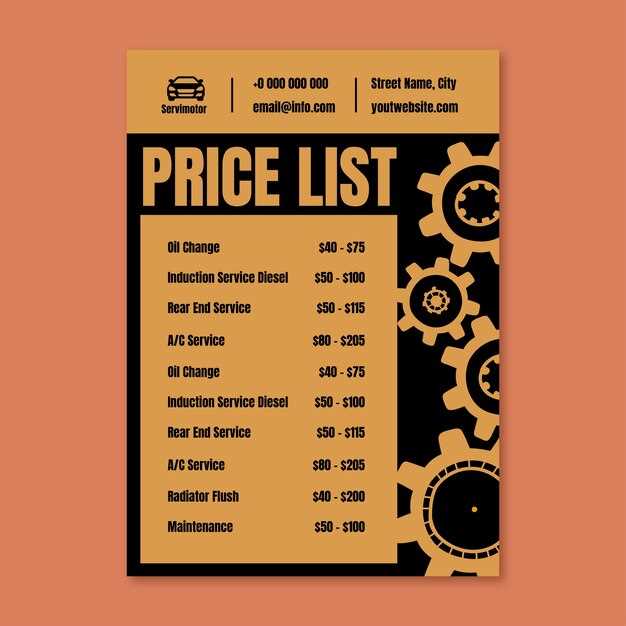
How to create a car maintenance schedule

Regular upkeep of your vehicle is essential for ensuring its longevity and optimal performance. Creating a well-structured car maintenance schedule can help you track necessary services and prevent potential issues before they develop into costly repairs. A comprehensive plan not only extends the lifespan of your car but also enhances safety and reliability on the road.
To establish an effective schedule, consider the specific needs of your vehicle, including its make, model, and age. Different cars have varying requirements for service, such as oil changes, tire rotations, and fluid checks. By consulting your owner’s manual, you can identify factory-recommended maintenance intervals and tailor your schedule accordingly.
Additionally, incorporating monthly or seasonal inspections into your routine can be beneficial. Look for signs of wear and tear, and address any minor issues promptly. This proactive approach to car maintenance not only saves you money in the long run but also ensures that you enjoy a safe and smooth driving experience.
Assessing Your Vehicle’s Specific Needs

Understanding your vehicle’s specific maintenance needs is crucial for effective upkeep and optimal performance. Here are the steps to help you assess what services your car requires:
- Consult the Owner’s Manual:
Your vehicle’s owner manual is the primary source of information regarding recommended service intervals and maintenance tasks. Be sure to review:
- Manufacturer’s maintenance schedule
- Fluids and filters specifications
- Tire maintenance recommendations
- Evaluate Driving Conditions:
Consider the environments in which you typically drive. Factors such as:
- Frequent short trips
- Driving in extreme temperatures
- Use of the vehicle for towing or heavy loads
may necessitate more frequent service.
- Check Mileage and Age:
Your vehicle’s age and mileage play significant roles in its upkeep needs. Be attentive to:
- Scheduled maintenance based on mileage
- Age-related wear and tear
- Component replacement timelines
- Monitor Performance:
Keep an eye on any changes in your vehicle’s performance. Signs that indicate service may be required include:
- Unusual noises or vibrations
- Warning lights on the dashboard
- Reduced fuel efficiency
- Consider Professional Inspections:
Schedule periodic inspections with a qualified mechanic. They can provide insights on:
- Identifying potential issues
- Assessing the overall condition of essential systems
- Recommending tailored maintenance plans
By carefully assessing your vehicle’s specific needs, you can establish a proactive maintenance schedule that ensures longevity and reliability on the road.
Determining the Frequency of Essential Services

Establishing a car maintenance schedule begins with understanding the frequency of essential services necessary for optimal vehicle performance. Regular upkeep is vital to prolong the life of your car and ensure safety on the road.
One primary factor in determining service frequency is the manufacturer’s recommendations, typically found in the owner’s manual. These guidelines provide specific intervals for various services, such as oil changes, tire rotations, and brake inspections. Following these recommendations helps maintain the manufacturer’s warranty and ensures the vehicle operates as intended.
Another critical aspect is monitoring driving habits. Frequent short trips and stop-and-go traffic can lead to increased wear on components, necessitating more regular services. Conversely, highway driving may allow for extended intervals between services.
Environmental conditions also influence maintenance frequency. Drivers in harsh climates–extreme heat, cold, or areas with heavy salt exposure–should consider more frequent inspections and services to mitigate damage from these conditions.
Ultimately, keeping a detailed service log can help track when essential maintenance was last performed and highlight patterns in vehicle performance, aiding in determining if adjustments to service frequency are necessary. By being proactive and attentive, you ensure your vehicle remains reliable and safe for years to come.
Tracking and Adjusting Your Maintenance Plan
Regular tracking of your car’s upkeep is essential for ensuring longevity and optimal performance. Begin by keeping a detailed log of all services performed, including oil changes, tire rotations, and brake inspections. This record provides insights into your vehicle’s condition and helps identify patterns that may necessitate adjustments in your maintenance schedule.
Setting reminders for upcoming service tasks can enhance your ability to stay on track. Utilize digital tools like calendars or dedicated apps that alert you when it’s time for routine maintenance. This proactive approach not only prevents potential issues but also promotes a more efficient use of time and resources.
As you monitor your vehicle’s performance, be open to adjusting your maintenance plan based on specific needs and driving habits. For instance, if you frequently drive in harsh conditions–such as extreme temperatures or rough terrains–consider increasing the frequency of essential services. Staying flexible ensures that your vehicle receives the necessary attention to perform reliably.
Additionally, after each service, evaluate your driving patterns. If your commute changes or if you spend more time in stop-and-go traffic, recalibrating your maintenance intervals may be warranted. A vehicle’s needs evolve, and a maintenance plan should adapt accordingly to account for these changes.
Ultimately, tracking and adjusting your maintenance plan is about staying informed and proactive. By maintaining a close watch on your car’s upkeep and being willing to adapt as necessary, you can ensure consistent service and prolong the life of your vehicle.